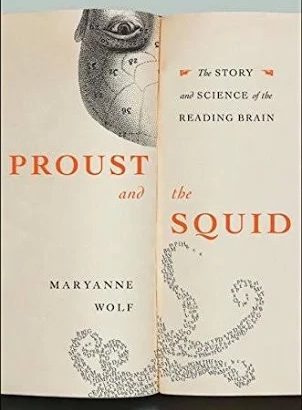Proust and the Squid: The story and science of the reading brain, by Dr. Maryanne Wolf
Dr. Maryanne Wolf has authored more than 160 scientific articles, she designed the RAVE-O reading intervention for children with dyslexia, and with Martha Denckla, co-authored the RAN/RAS naming speed tests, a major predictor of dyslexia across all languages.
Currently she’s the director of the Center for Dyslexia, Diverse Learners, and Social Justice at UCLA.
Dr. Wolf has written several books on reading, all of them worth your time. But this one — Proust and the Squid — is spectacular! This book gives you the foundation in history and neuroscience required to sort true research from educational marketing.
Proust and the Squid?
The title is what first intrigued me; what does Proust have to do with a squid? Wolf explains; Marcel Proust, who wrote On Reading, serves as a metaphor for reading at the highest level in which we do more than decode or comprehend, but go beyond the text to think, reason, question, and experience thousands of different realities. (p. 5)
Where does the squid come in?
“Scientists in the 1950’s used the long central axon of the shy but cunning squid to understand how neurons fire and transmit to each other…repair and compensate.” (p. 5) To discover the depths of the reading brain, Dr. Wolf combined neuroscience (squid) with reading at its best (Proust). Remarkably, she kept me fascinated to the last page.
Dyslexia
Because my area of interest is dyslexia, I hoped Proust and the Squid would add to my understanding. I wasn’t disappointed. I learned a great deal about the reading brain and the differences in brain structure that can produce what we call dyslexia.
One Size Doesn’t Fit All
The research on dyslexia needs to connect what we know to how we teach. Wolf points out that “children struggling to read aren’t going to be helped by the one-size-fits-all approach that is typical…Rather we need teachers trained to use a toolbox of principles that they can apply to different types of children…There are no universally effective programs, but there are knowable principles….” (p. 209)
Exactly so! This is why I wrote Dyslexic Tool Kit Expanded Edition: What to do when phonics isn’t enough.
Dyslexic Advantage
As the Eide’s so eloquently show in The Dyslexic Advantage, Wolf points out that the dyslexic brain is different, not less. “…very different organizations of the brain are possible. Some organizations may not work well for reading, yet are critical for the creation of buildings and art and the recognition of patterns — whether on ancient battlefields or in biopsy slides. Some of these variations of the brain’s organization may lend themselves to the requirements of modes of communication just on the horizon.” (p. 215) She published this book in 2008, and already her prediction is proving true. To see how, visit Made by Dyslexia for delightful videos describing dyslexic brains at work in various fields.
The Power of Words
Maryanne Wolf understands the power of words. She wants the gift of reading to be passed down to every child, regardless of where they are born or how well off their parents are. She insists that teaching must adapt to brain structure. Children cannot be required to adjust their brain structure to our teaching methods.
Proust and the Squid is a Bright Light
Proust and the Squid sheds a great deal of light on the history of the reading brain and where we need to go from here in research and in education. I HIGHLY recommend this book for all educators and especially for anyone who works with dyslexic children. This is real science of reading, NOT the kind you find on social media claiming to sell the one and only way to teach reading to all children.
Reviewed by Yvonna Graham, www.dyslexiakit.net
@GrahamYvonna
